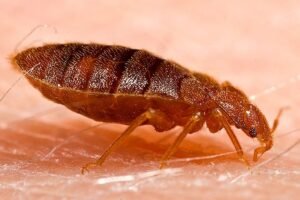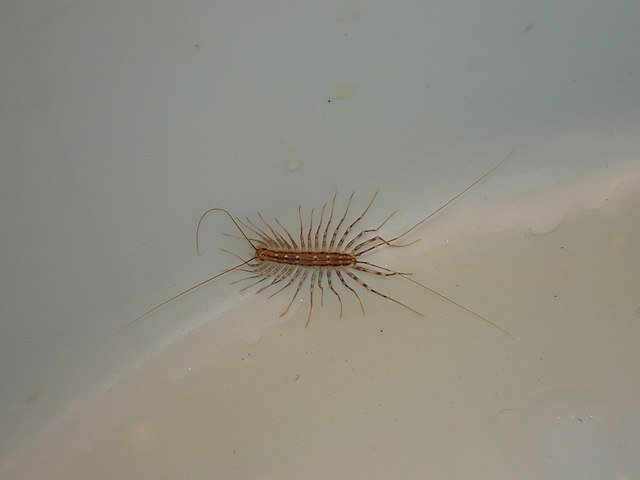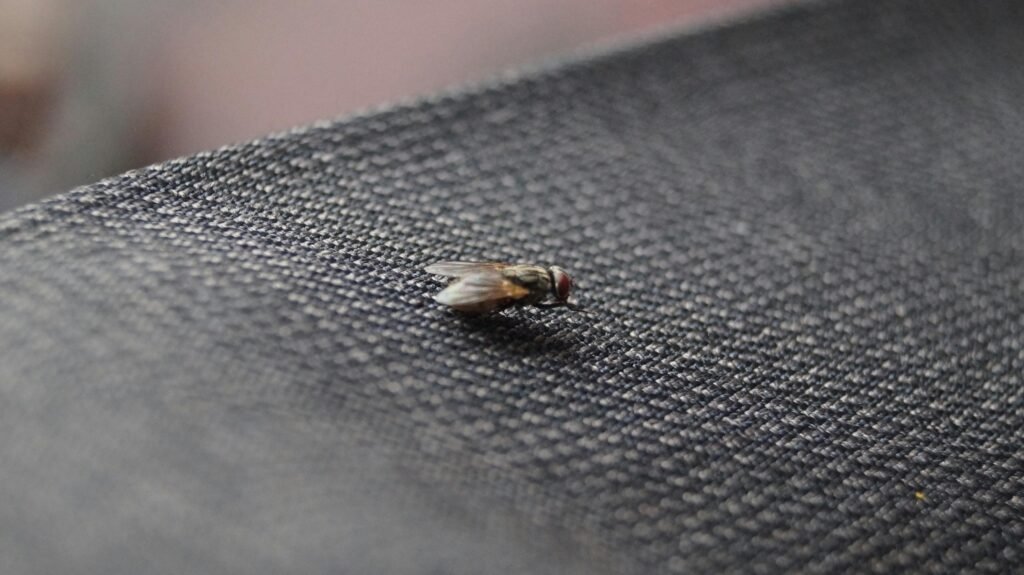Bed Bugs (Cimex lectularius): Identification, Risks, and Complete Control Guide
 Bed bugs (Cimex lectularius) are small, blood-feeding insects that have shared human homes for centuries. Unlike fleas or ticks, bed bugs do not transmit major diseases, but their bites cause itching, allergic reactions, and psychological stress. They are notorious for their stealth: emerging at night, hiding during the day, and spreading quickly between rooms, apartments, or even cities through human travel.
Bed bugs (Cimex lectularius) are small, blood-feeding insects that have shared human homes for centuries. Unlike fleas or ticks, bed bugs do not transmit major diseases, but their bites cause itching, allergic reactions, and psychological stress. They are notorious for their stealth: emerging at night, hiding during the day, and spreading quickly between rooms, apartments, or even cities through human travel.
In the past, bed bugs were nearly eradicated in many regions thanks to powerful insecticides. However, global travel and pesticide resistance have led to a dramatic resurgence since the 1990s. Today, bed bugs are found in luxury hotels, urban apartments, suburban homes, and even offices and public transportation.
This article explores the biology, identification, global spread, damage, detection, and advanced control strategies for bed bugs in beds—equipping you with everything needed to understand and manage this pest.
Identification
Size: Adult bed bugs are 4–7 mm long, about the size of an apple seed.
Shape: Flat, oval bodies before feeding; swollen and reddish-brown after feeding.
Color: Light brown to mahogany in adults; nymphs are pale or translucent.
Wings: Wingless; instead, they have small wing pads.
Eggs: Pearl-white, about 1 mm long, often glued in clusters in cracks.
Unlike cockroaches, which are fast runners, bed bugs move slowly. They also lack the jumping ability of fleas. Their main adaptation is stealth—hiding in mattress seams, box springs, baseboards, and electrical outlets.
Biology and Ecology
Feeding: Bed bugs are obligate hematophages—feeding only on blood, primarily from humans.
Hosts: While humans are the main host, bed bugs will occasionally feed on pets like cats or dogs.
Life cycle:
Eggs hatch in 6–10 days.
Five nymphal stages, each requiring a blood meal.
Adults can live 6–12 months, with females laying 1–5 eggs per day.
Activity: Nocturnal, feeding mainly between 1 a.m. and 5 a.m.
Survival: Can survive months without feeding, especially in cool environments.
Bed bugs thrive in cluttered environments, where they can hide undisturbed, but they are not linked to poor hygiene—they infest both clean and dirty places equally.
Global Distribution
Bed bugs (Cimex lectularius) are cosmopolitan. They are found on every continent except Antarctica.
North America: Major resurgence in urban centers like New York, Toronto, and Chicago.
Europe: London, Paris, and Berlin face frequent outbreaks in hotels and hostels.
Asia: Dense cities such as Mumbai, Beijing, and Tokyo struggle with infestations in both homes and public transit.
Africa & South America: Often underreported, but infestations are increasing due to urbanization.
Australia: International tourism has fueled steady spread.
The increase in international travel is the single largest factor behind modern bed bug resurgence. Luggage, clothing, and used furniture are the main transport vehicles.
Risks and Damage
Health Risks
Bites: Cause red, itchy welts, often in linear or clustered patterns.
Allergic reactions: Some people develop hives or severe swelling.
Secondary infections: Scratching can lead to bacterial infections.
Mental health: Anxiety, insomnia, and social embarrassment are common.
Economic Damage
Costly extermination treatments.
Loss of business reputation for hotels and landlords.
Reduced property value in heavily infested buildings.
Disease Transmission
While bed bugs are not major vectors like mosquitoes or ticks, studies suggest they may mechanically carry pathogens such as hepatitis B or Trypanosoma cruzi (Chagas disease agent). However, confirmed transmission to humans remains rare.
Signs of Infestation
Bites: Clusters of itchy red marks, often on arms, neck, or legs.
Stains: Rust-colored blood spots or black fecal dots on sheets and mattresses.
Odor: Heavy infestations produce a sweet, musty smell.
Live insects: Adults and nymphs visible in mattress seams or bed frames.
Cast skins: Shed exoskeletons from molting nymphs.
Eggs: Tiny white eggs hidden in cracks.
Bed bugs often hide within 2–3 meters of sleeping areas but can spread further over time.
Control Methods
Non-Chemical Approaches
Heat treatment: Whole-room heating to 50–60°C kills all life stages.
Cold treatment: Freezing infested items for several days.
Vacuuming: Reduces populations when focused on cracks and seams.
Encasements: Special mattress and box spring covers trap bugs inside.
Decluttering: Removes hiding places.
Chemical Approaches
Insecticides: Pyrethroids, neonicotinoids, and desiccant dusts (e.g., silica gel).
Challenges: Widespread resistance to many products.
Professional treatments: Often combine chemicals with heat or steam.
DIY vs. Professional Control
DIY sprays rarely work for established infestations. Professional pest management, with integrated pest management (IPM) strategies, offers the most reliable long-term results.
Advanced Approaches
Canine detection: Specially trained dogs can locate infestations with high accuracy.
Heat chambers: Portable units treat infested luggage and furniture.
Biological control: Research is exploring natural predators such as certain spiders or fungi like Beauveria bassiana.
Genetic research: Studies on bed bug resistance mechanisms may lead to targeted controls.
Cultural and Historical Context
Ancient references: Bed bugs were documented in Greek and Roman writings.
Middle Ages: Common in European households.
20th century: Nearly eradicated in developed nations after World War II with DDT.
Modern resurgence: Resistance to insecticides and global travel sparked a comeback in the 1990s.
In popular culture, bed bugs symbolize discomfort and invasion of personal space. The phrase “Don’t let the bed bugs bite” reflects long-standing human awareness of this pest.
FAQ Section
Q1: How do bed bugs spread from place to place?
They hitchhike on luggage, clothing, used furniture, and even electronics.
Q2: Can bed bugs fly or jump?
No. They crawl slowly but efficiently, unlike fleas or flies.
Q3: Do bed bugs live only in beds?
No. They also hide in couches, chairs, electrical outlets, and baseboards.
Q4: Are bed bug bites dangerous?
They are usually not medically dangerous but can cause allergic reactions, infections, and mental stress.
Q5: Can you get rid of bed bugs without chemicals?
Yes. Heat treatments and encasements are effective non-chemical methods.
Q6: Why are bed bugs so hard to kill?
They hide in tiny cracks, reproduce quickly, and many populations are resistant to insecticides.
Final Thoughts
Bed bugs (Cimex lectularius) are one of the most persistent household pests in modern society. Their ability to hide, survive long periods without food, and spread rapidly makes them especially difficult to eliminate once established. Unlike cockroaches or ants, which can often be controlled with basic measures, bed bugs require a systematic approach that combines prevention, monitoring, and targeted treatment.
While infestations can be stressful and costly, solutions exist. Professional pest control companies use integrated pest management (IPM) techniques, combining chemical, non-chemical, and heat treatments to ensure results. For homeowners, awareness and vigilance are the strongest tools—regular inspection of beds, cautious handling of second-hand furniture, and early intervention are essential.
Bed bugs are not just a nuisance; they are a reminder of how closely human history and insect evolution are linked. With persistence and science-driven approaches, it is possible to keep them under control and reclaim peace of mind at home.
Disclaimer
This article is for informational purposes only. Pest control laws and approved chemicals vary by country. For best results and legal safety, we strongly recommend contacting a licensed pest control professional in your local area. Always make sure that the pest control technician is properly certified or licensed, depending on your country’s regulations. It’s important to confirm that they only use approved products and apply them exactly as instructed on the product label. In most places in Europe, UK, or USA, following label directions is not just best practice—it’s the law.
Author Bio
Nasos Iliopoulos, BSc Agronomist & Certified Pest Control Expert
Scientific Director – Advance Services (Athens, Greece)
Licensed Pest Control Business – Ministry of Rural Development & Food (GR)
References
Harvard Health - How to check for bed bugs — and what to do if you find them
University of Kentucky - Bed Bugs
Romero, A., Potter, M.F., & Haynes, K.F. (2007). Insecticide Resistance in the Bed Bug: A Factor in the Pest’s Sudden Resurgence? Journal of Medical Entomology.
Wang, C., & Wen, X. (2011). Bed Bug Infestations and Control Practices in China: Implications for Global Management. Insects Journal.
Reinhardt, K., & Siva-Jothy, M.T. (2007). Biology of the Bed Bug (Cimicidae). Annual Review of Entomology.


